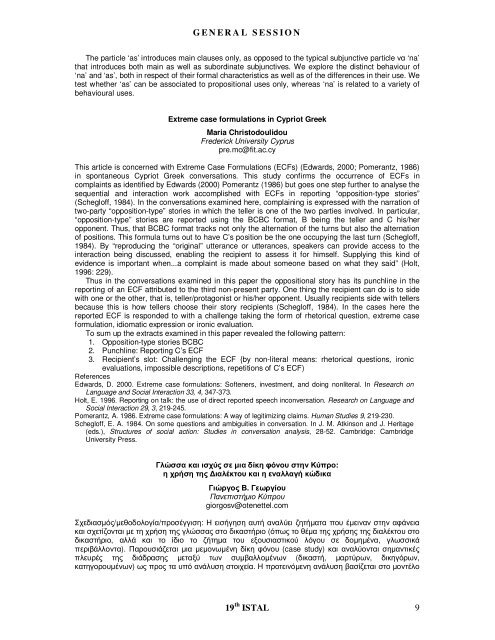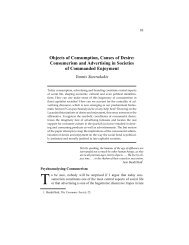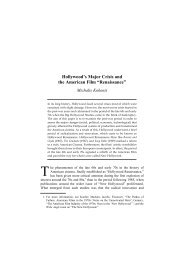19 International Symposium on Theoretical and Applied Linguistics ...
19 International Symposium on Theoretical and Applied Linguistics ...
19 International Symposium on Theoretical and Applied Linguistics ...
You also want an ePaper? Increase the reach of your titles
YUMPU automatically turns print PDFs into web optimized ePapers that Google loves.
G E N E R A L S E S S I O N<br />
The particle ‘as’ introduces main clauses <strong>on</strong>ly, as opposed to the typical subjunctive particle να ‘na’<br />
that introduces both main as well as subordinate subjunctives. We explore the distinct behaviour of<br />
‘na’ <strong>and</strong> ‘as’, both in respect of their formal characteristics as well as of the differences in their use. We<br />
test whether ‘as’ can be associated to propositi<strong>on</strong>al uses <strong>on</strong>ly, whereas ‘na’ is related to a variety of<br />
behavioural uses.<br />
Extreme case formulati<strong>on</strong>s in Cypriot Greek<br />
Maria Christodoulidou<br />
Frederick University Cyprus<br />
pre.mc@fit.ac.cy<br />
This article is c<strong>on</strong>cerned with Extreme Case Formulati<strong>on</strong>s (ECFs) (Edwards, 2000; Pomerantz, <str<strong>on</strong>g>19</str<strong>on</strong>g>86)<br />
in sp<strong>on</strong>taneous Cypriot Greek c<strong>on</strong>versati<strong>on</strong>s. This study c<strong>on</strong>firms the occurrence of ECFs in<br />
complaints as identified by Edwards (2000) Pomerantz (<str<strong>on</strong>g>19</str<strong>on</strong>g>86) but goes <strong>on</strong>e step further to analyse the<br />
sequential <strong>and</strong> interacti<strong>on</strong> work accomplished with ECFs in reporting “oppositi<strong>on</strong>-type stories”<br />
(Schegloff, <str<strong>on</strong>g>19</str<strong>on</strong>g>84). In the c<strong>on</strong>versati<strong>on</strong>s examined here, complaining is expressed with the narrati<strong>on</strong> of<br />
two-party “oppositi<strong>on</strong>-type” stories in which the teller is <strong>on</strong>e of the two parties involved. In particular,<br />
“oppositi<strong>on</strong>-type” stories are reported using the BCBC format, B being the teller <strong>and</strong> C his/her<br />
opp<strong>on</strong>ent. Thus, that BCBC format tracks not <strong>on</strong>ly the alternati<strong>on</strong> of the turns but also the alternati<strong>on</strong><br />
of positi<strong>on</strong>s. This formula turns out to have C’s positi<strong>on</strong> be the <strong>on</strong>e occupying the last turn (Schegloff,<br />
<str<strong>on</strong>g>19</str<strong>on</strong>g>84). By “reproducing the “original” utterance or utterances, speakers can provide access to the<br />
interacti<strong>on</strong> being discussed, enabling the recipient to assess it for himself. Supplying this kind of<br />
evidence is important when...a complaint is made about some<strong>on</strong>e based <strong>on</strong> what they said” (Holt,<br />
<str<strong>on</strong>g>19</str<strong>on</strong>g>96: 229).<br />
Thus in the c<strong>on</strong>versati<strong>on</strong>s examined in this paper the oppositi<strong>on</strong>al story has its punchline in the<br />
reporting of an ECF attributed to the third n<strong>on</strong>-present party. One thing the recipient can do is to side<br />
with <strong>on</strong>e or the other, that is, teller/protag<strong>on</strong>ist or his/her opp<strong>on</strong>ent. Usually recipients side with tellers<br />
because this is how tellers choose their story recipients (Schegloff, <str<strong>on</strong>g>19</str<strong>on</strong>g>84). In the cases here the<br />
reported ECF is resp<strong>on</strong>ded to with a challenge taking the form of rhetorical questi<strong>on</strong>, extreme case<br />
formulati<strong>on</strong>, idiomatic expressi<strong>on</strong> or ir<strong>on</strong>ic evaluati<strong>on</strong>.<br />
To sum up the extracts examined in this paper revealed the following pattern:<br />
1. Oppositi<strong>on</strong>-type stories BCBC<br />
2. Punchline: Reporting C’s ECF<br />
3. Recipient’s slot: Challenging the ECF {by n<strong>on</strong>-literal means: rhetorical questi<strong>on</strong>s, ir<strong>on</strong>ic<br />
evaluati<strong>on</strong>s, impossible descripti<strong>on</strong>s, repetiti<strong>on</strong>s of C’s ECF)<br />
References<br />
Edwards, D. 2000. Extreme case formulati<strong>on</strong>s: Softeners, investment, <strong>and</strong> doing n<strong>on</strong>literal. In Research <strong>on</strong><br />
Language <strong>and</strong> Social Interacti<strong>on</strong> 33, 4, 347-373.<br />
Holt, E. <str<strong>on</strong>g>19</str<strong>on</strong>g>96. Reporting <strong>on</strong> talk: the use of direct reported speech inc<strong>on</strong>versati<strong>on</strong>. Research <strong>on</strong> Language <strong>and</strong><br />
Social Interacti<strong>on</strong> 29, 3, 2<str<strong>on</strong>g>19</str<strong>on</strong>g>-245.<br />
Pomerantz, A. <str<strong>on</strong>g>19</str<strong>on</strong>g>86. Extreme case formulati<strong>on</strong>s: A way of legitimizing claims. Human Studies 9, 2<str<strong>on</strong>g>19</str<strong>on</strong>g>-230.<br />
Schegloff, E. A. <str<strong>on</strong>g>19</str<strong>on</strong>g>84. On some questi<strong>on</strong>s <strong>and</strong> ambiguities in c<strong>on</strong>versati<strong>on</strong>. In J. M. Atkins<strong>on</strong> <strong>and</strong> J. Heritage<br />
(eds.), Structures of social acti<strong>on</strong>: Studies in c<strong>on</strong>versati<strong>on</strong> analysis, 28-52. Cambridge: Cambridge<br />
University Press.<br />
Γλώσσα και ισχύς σε µια δίκη φόνου στην Κύπρο:<br />
η χρήση της ∆ιαλέκτου και η εναλλαγή κώδικα<br />
Γιώργος Β. Γεωργίου<br />
Πανεπιστήµιο Κύπρου<br />
giorgosv@otenettel.com<br />
Σχεδιασµός/µεθοδολογία/προσέγγιση: Η εισήγηση αυτή αναλύει ζητήµατα που έµειναν στην αφάνεια<br />
και σχετίζονται µε τη χρήση της γλώσσας στο δικαστήριο (όπως το θέµα της χρήσης της διαλέκτου στο<br />
δικαστήριο, αλλά και το ίδιο το ζήτηµα του εξουσιαστικού λόγου σε δοµηµένα, γλωσσικά<br />
περιβάλλοντα). Παρουσιάζεται µια µεµονωµένη δίκη φόνου (case study) και αναλύονται σηµαντικές<br />
πλευρές της διάδρασης µεταξύ των συµβαλλοµένων (δικαστή, µαρτύρων, δικηγόρων,<br />
κατηγορουµένων) ως προς τα υπό ανάλυση στοιχεία. Η προτεινόµενη ανάλυση βασίζεται στο µοντέλο<br />
<str<strong>on</strong>g>19</str<strong>on</strong>g> th ISTAL 9






